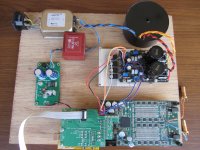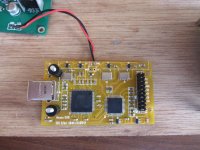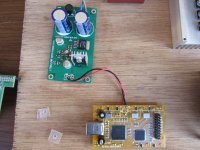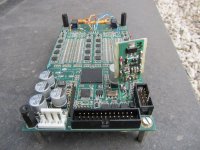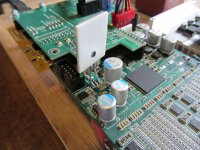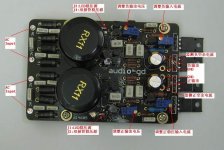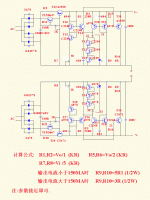randytsuch's audio page: Soekris R2R Dam Dac - Modding
guide/ideas for batt power
been playin with the 1387 as well using the tda1387 mod thread as guidance
its great cheap chip
sounds good, i havent finished development but its hard to imagine it ever surpassing the sheer resolution of my modded 1021
guide/ideas for batt power
been playin with the 1387 as well using the tda1387 mod thread as guidance
its great cheap chip
sounds good, i havent finished development but its hard to imagine it ever surpassing the sheer resolution of my modded 1021
Many thanks for that reply matt_garman - I find your enthusiasm infectious and it has made me very excited now about the arrival and possibilities (both learning and sonic enjoyment) ahead of me with the Soekris dam1021 board!
I'll be honest that I didn't achieve much sonic improvement whilst modding my TDA1387 boards (but really want to praise all of your advice). I found the outcome of a lot of the modding to be quite disappointing which led to a bit of a dead end. I think that this may have a lot to do with personal taste perhaps?
However, that has not deterred me to continue with this hobby by any means - I just needed to find a project with plenty of options and instructions and the hope of building a high quality DAC - the fact that I noticed your comments on the board enthused me further
The other area of opportunity that excites me is linking the board with an Arduino / Raspberry PI or any of the 'dev boards' around - this however opens a whole new area of research I imagine!
Thanks again for your TDA1387 guide - hope to chat more once my Soekris dam1021 board arrives.
Happy modding Matt
I'll be honest that I didn't achieve much sonic improvement whilst modding my TDA1387 boards (but really want to praise all of your advice). I found the outcome of a lot of the modding to be quite disappointing which led to a bit of a dead end. I think that this may have a lot to do with personal taste perhaps?
However, that has not deterred me to continue with this hobby by any means - I just needed to find a project with plenty of options and instructions and the hope of building a high quality DAC - the fact that I noticed your comments on the board enthused me further

The other area of opportunity that excites me is linking the board with an Arduino / Raspberry PI or any of the 'dev boards' around - this however opens a whole new area of research I imagine!
Thanks again for your TDA1387 guide - hope to chat more once my Soekris dam1021 board arrives.
Happy modding Matt
Last edited:
Hello,
Here are the latest mods I did to the Soekris DAC that it lifted a few notches up in sound quality
I have a Soekris v1 DAC with the lowresmod and plenty of vref capacitors on the backside added
The easiest one was to replace the Amanero interface with another Amanero that I found on Taobao,
that new Amanero has better clocks (C3391) and a better PS: 6 LDOs instead of 2 on the PCB.
I also removed the +5V USB PS and added a dedicated LT1963+LT3042 PS for the new Amanero.
I just noticed that for 2017 that Taobao Amanero is being replaced with one that has I2S isolation.
I had some muzgdiy 3.1 voltage regulators that I finally got the courage to install, especially with the help of a new hdmi microscope
I replaced the 3.3v LDO regulator that is used for the clock.
The result of this is better detail, better separations of instruments, ...
I noticed that I got to hear the echos of the instruments.
Of course this is all subjective
Regards,
Danny
Here are the latest mods I did to the Soekris DAC that it lifted a few notches up in sound quality
I have a Soekris v1 DAC with the lowresmod and plenty of vref capacitors on the backside added
The easiest one was to replace the Amanero interface with another Amanero that I found on Taobao,
that new Amanero has better clocks (C3391) and a better PS: 6 LDOs instead of 2 on the PCB.
I also removed the +5V USB PS and added a dedicated LT1963+LT3042 PS for the new Amanero.
I just noticed that for 2017 that Taobao Amanero is being replaced with one that has I2S isolation.
I had some muzgdiy 3.1 voltage regulators that I finally got the courage to install, especially with the help of a new hdmi microscope
I replaced the 3.3v LDO regulator that is used for the clock.
The result of this is better detail, better separations of instruments, ...
I noticed that I got to hear the echos of the instruments.
Of course this is all subjective
Regards,
Danny
Attachments
Last edited:
Hello,
Here are the latest mods I did to the Soekris DAC that it lifted a few notches up in sound quality
Danny, what is the power supply you're using for the dam1021 board itself? (The one just below the black toroid in your first pic)
Thanks,
Matt
Many thanks for that reply matt_garman - I find your enthusiasm infectious and it has made me very excited now about the arrival and possibilities (both learning and sonic enjoyment) ahead of me with the Soekris dam1021 board!
Thanks!

I'll be honest that I didn't achieve much sonic improvement whilst modding my TDA1387 boards (but really want to praise all of your advice). I found the outcome of a lot of the modding to be quite disappointing which led to a bit of a dead end. I think that this may have a lot to do with personal taste perhaps?
Different strokes for different folks. There's rarely any consensus in audio, DIY or off-the-shelf. That's not just DACs, but speakers, amps, etc etc. If we all agreed on what was best we'd just do it and there wouldn't be much learning left to be done, nor much to discuss. And in general, I think there's always a risk with DIY that the final result won't be what you want or were looking for. But, as long as you enjoy the process itself, then there's really no loss in my opinion.
The other area of opportunity that excites me is linking the board with an Arduino / Raspberry PI or any of the 'dev boards' around - this however opens a whole new area of research I imagine!
Indeed, that opened up a whole new world for me. I don't think I'll ever be able to build a standalone DAC again, not when I can throw in an SBC and have a full-on music server plus an implicit microcontroller... the end result: the only limitation is creativity.
Enjoy and keep us posted on your DAM1021 progress!
randytsuch's audio page: Soekris R2R Dam Dac - Modding
guide/ideas for batt power
been playin with the 1387 as well using the tda1387 mod thread as guidance
its great cheap chip
sounds good, i havent finished development but its hard to imagine it ever surpassing the sheer resolution of my modded 1021
Hi, Nige2000,
Have you got the chance to play with DAM1121? Any impression? There is no much room for mod but it has separate supply for analog and digital. Thanks.
WYAN
Hi, Nige2000,
Have you got the chance to play with DAM1121? Any impression? There is no much room for mod but it has separate supply for analog and digital. Thanks.
WYAN
hope.... havent touched it yet,
ive kinda been taking a break from this project, ill need to be in a patient frame of mind when i go at it, hopefully ill be back with fresh enthusiasm
id prefer to see fixed clocks on it close to the shift register flipflops
the rest is workable, but again all very small
would be nice to have a few boards to experiment on, but cost is too much for that
but again all very small
For all this small soldering I bought a hdmi microscope, it makes SMD soldering easy and let you inspect the result.
Be sure to buy a HDMI microscope with a high fps, the USB ones have low fps for high definition = unworkable.
I also added a 0.5x Barlow lens, that gives me about 25cm of workable space between the PCB and the lens.
It's nice to see in realtime those SMT components as 1-2cm objects on the screen
Last edited:
Sœren > Pardon me for maybe jumping the gun a little but I have a couple of questions regarding the upcoming 1231 for the Raspberry Pi. From what I've gathered thus far it'll run off of 5V DC just like the Pi. How much current will it draw and how "clean" will the PSU have to be for best performance? (Within reason) Will a typical DC-DC converter do the job or should I be planning for a more fancy solution? In the past you've had on-board regulation so I'm assuming this one will have that as well. 
Will there be a practical way of powering the Pi through the 1231 using the GPIO? And will there be a max current when doing this? It becomes an issue if you intend to power a hdd with the Pi USB. I'm just trying to get a basic understanding of how I need to structure the power supply.
Will there be a practical way of powering the Pi through the 1231 using the GPIO? And will there be a max current when doing this? It becomes an issue if you intend to power a hdd with the Pi USB. I'm just trying to get a basic understanding of how I need to structure the power supply.
Sœren > Pardon me for maybe jumping the gun a little but I have a couple of questions regarding the upcoming 1231 for the Raspberry Pi. From what I've gathered thus far it'll run off of 5V DC just like the Pi. How much current will it draw and how "clean" will the PSU have to be for best performance? (Within reason) Will a typical DC-DC converter do the job or should I be planning for a more fancy solution? In the past you've had on-board regulation so I'm assuming this one will have that as well.
Will there be a practical way of powering the Pi through the 1231 using the GPIO? And will there be a max current when doing this? It becomes an issue if you intend to power a hdd with the Pi USB. I'm just trying to get a basic understanding of how I need to structure the power supply.
Yes, it will run of 5V, either supplied by the Raspberry Pi, or by a 5V DC Plug, when powering though the dam1231's DC Plug it will have have power management, just simple controlled power down. You can use any 5V Power supply, up to 5A if needed....
Internally there is a 5V to +-7V DC-DC converter, followed by high performance low noise discrete regulators....
DC input for the DAM1021 calls for a bipolar power supply.
In general, for some devices that require bipolar DC input, it is acceptable to use two single-rail power supplies. One is positive and ground as usual; the other gets its positive rail treated as ground, and ground treated as the negative rail.
Is this acceptable to do with the DAM1021?
Looks like the two middle pins of J1 are common to each other (i.e. I believe both are ground potential for the dam1021 board).
If this is OK for the DAM, is there any kind of power supply that wouldn't tolerate this configuration?
Thanks!
In general, for some devices that require bipolar DC input, it is acceptable to use two single-rail power supplies. One is positive and ground as usual; the other gets its positive rail treated as ground, and ground treated as the negative rail.
Is this acceptable to do with the DAM1021?
Looks like the two middle pins of J1 are common to each other (i.e. I believe both are ground potential for the dam1021 board).
If this is OK for the DAM, is there any kind of power supply that wouldn't tolerate this configuration?
Thanks!
DC input for the DAM1021 calls for a bipolar power supply.
In general, for some devices that require bipolar DC input, it is acceptable to use two single-rail power supplies. One is positive and ground as usual; the other gets its positive rail treated as ground, and ground treated as the negative rail.
Is this acceptable to do with the DAM1021?
Looks like the two middle pins of J1 are common to each other (i.e. I believe both are ground potential for the dam1021 board).
If this is OK for the DAM, is there any kind of power supply that wouldn't tolerate this configuration?
Thanks!
yea two middle pins of j1 is gnd
using two supplies for bipolar is fine as long as there floating
I have another "randomly loses sync" issue. Setup: two dam1021 boards in balanced dual mono config; input is I2S via Raspberry Pi; using Normunds' input+switch board to connect the two boards plus Rpi. DAM boards are powered by DIYINHK LT3042 power supplies at +/- 12V.
Most of the time everything just works as expected. Randomly, though, the dam1021 boards will lose sync. When this happens, it is most likely to occur right when a new song starts. This is how it usually goes over:
I spent several hours listening, and this happened so little (maybe not at all?) that I thought I could live with it. But then I put a new album in the playlist. And it started consistently doing it at the start of every single song.
I thought it might have something to do with the files, but my entire collection is all FLAC-encoded CD rips (i.e. 16/44 redbook audio).
So then I thought it might have something to do with the RPi and/or software running on that. I shut down the system for a few days, came back last night. Turned it on, started playing the same album. No issues. So clearly it's not specific to those particular song files.
Any thoughts on where I might want to look given the description of the problem?
Most of the time everything just works as expected. Randomly, though, the dam1021 boards will lose sync. When this happens, it is most likely to occur right when a new song starts. This is how it usually goes over:
- New song starts, plays normally very briefly, maybe one or two seconds
- Both DAM boards lose sync (on-board LED starts flashing), brief silence for one or two seconds
- One board (i.e. one channel) regains sync, starts playing; other board/channel is still silent, again one or two seconds
- The channels swap, so the previously silent one starts playing, and the other goes silent. Another 1-2 secs.
- The other channel recovers and both resume playing normally.
I spent several hours listening, and this happened so little (maybe not at all?) that I thought I could live with it. But then I put a new album in the playlist. And it started consistently doing it at the start of every single song.
I thought it might have something to do with the files, but my entire collection is all FLAC-encoded CD rips (i.e. 16/44 redbook audio).
So then I thought it might have something to do with the RPi and/or software running on that. I shut down the system for a few days, came back last night. Turned it on, started playing the same album. No issues. So clearly it's not specific to those particular song files.
Any thoughts on where I might want to look given the description of the problem?
- Home
- Vendor's Bazaar
- Reference DAC Module - Discrete R-2R Sign Magnitude 24 bit 384 KHz
